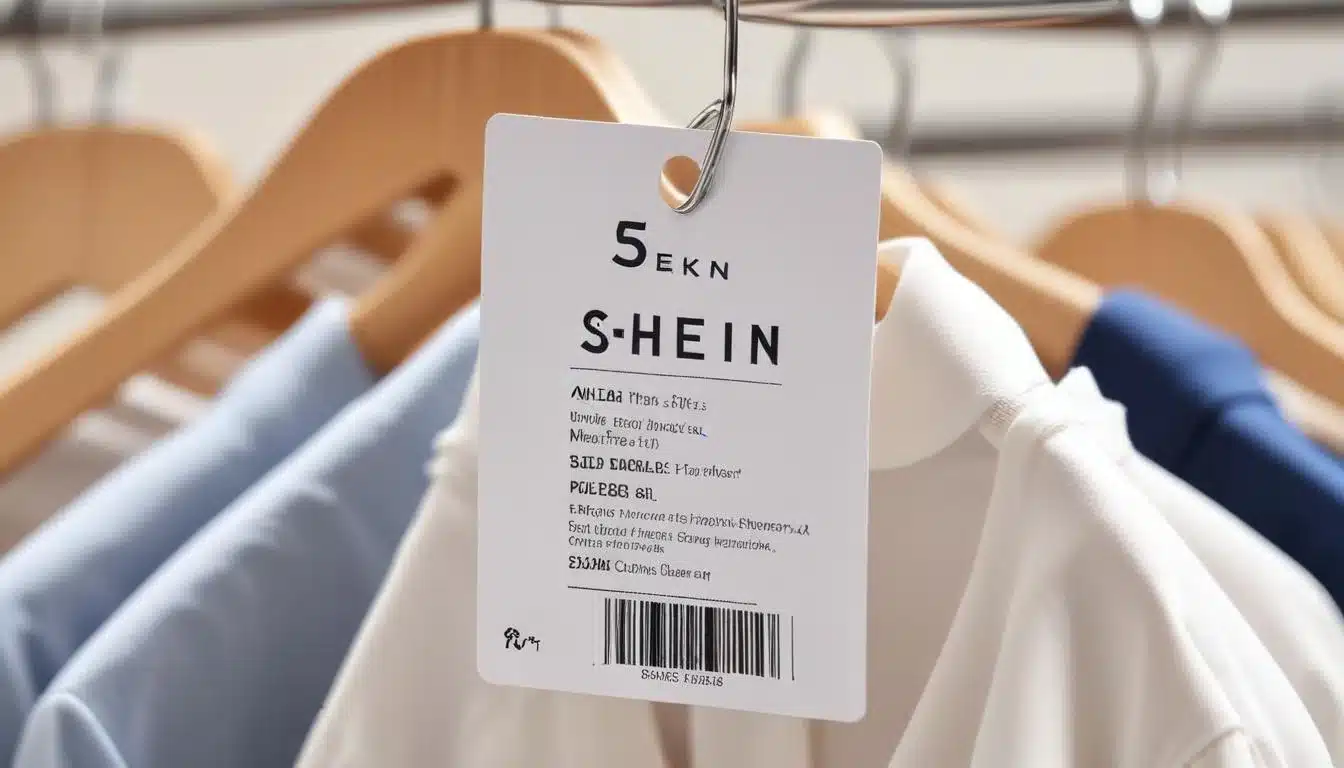Decoding Shein’s Quality Control: Are 5-Star Reviews Real? (2025)

Ads
When it comes to the world of fast fashion, few brands generate as much buzz and debate as Shein. Shoppers worldwide are often drawn to its incredibly low prices and vast selection, yet a persistent question remains: Is the quality genuinely good, and are those numerous Shein quality control 5-star reviews truly real in 2025?
Shein has become synonymous with accessible trends, but the sheer volume of products and rapid turnover can make assessing actual product quality a challenge. This article delves deep into Shein’s quality control processes, examining the factors that influence product consistency, the authenticity of customer reviews, and providing practical advice for navigating your shopping experience on the platform in 2025.
Ads
Understanding Shein’s Fast Fashion Model
Shein operates on an ultra-fast fashion model, a strategy that allows it to quickly design, manufacture, and distribute trendy clothing. This approach is central to its appeal, as it enables the company to offer an ever-changing inventory that mirrors the latest runway and social media trends almost instantaneously.
The rapid cycle from design to delivery is a key differentiator for Shein. Unlike traditional fashion retailers that might have several collections per year, Shein introduces thousands of new items weekly. This constant influx keeps the catalog fresh and exciting for consumers, but it also raises questions about how quality can be maintained at such a breakneck pace.
Ads
The ‘Test and Reorder’ Strategy
- Small Batch Production: Shein often starts with small production runs for new designs to gauge market interest.
- Data-Driven Decisions: AI and big data analytics are used to identify trending styles and predict demand.
- Rapid Scalability: Successful items are quickly scaled up for mass production, while unpopular ones are discontinued.
This ‘test and reorder’ system minimizes financial risk and ensures that inventory is always aligned with current consumer preferences. However, it also means that initial batches might have different quality characteristics than later, larger runs, contributing to inconsistencies often reported by customers.
Impact on Manufacturing and Sourcing
Shein partners with numerous independent manufacturers, primarily in China, to produce its vast array of items. This decentralized manufacturing network allows for incredible speed and flexibility. However, it also means that quality control can vary significantly from one supplier to another, making it difficult to establish a uniform standard across all products.
The pressure to produce quickly and affordably can sometimes lead to compromises in material selection and construction. While Shein asserts it has quality checks in place, the sheer volume and speed of production pose significant challenges to ensuring every item meets a consistent standard. Understanding this model is the first step in decoding the true nature of Shein’s product quality.
Dissecting Shein’s Quality Control Protocols in 2025
Shein’s quality control (QC) is a topic of intense discussion, especially given the brand’s immense scale and rapid production cycles. In 2025, Shein continues to evolve its QC protocols, aiming to balance affordability with acceptable product standards. Their approach is multi-faceted, involving both pre-production assessments and post-production checks.
Before manufacturing begins, Shein reportedly conducts material inspections and fabric testing to ensure they meet basic safety and quality requirements. This initial stage is crucial for identifying potential issues with durability, colorfastness, and comfort, though the effectiveness of these checks across their vast network of suppliers can vary.
Key Stages of Shein’s QC Process
- Material Inspection: Checking fabrics and components for defects before production.
- In-line Production Monitoring: Spot checks during the manufacturing process to catch errors early.
- Final Product Inspection: Assessing finished garments for stitching, sizing, and overall appearance before shipping.
Despite these stated processes, the challenge for Shein lies in the sheer volume of unique SKUs and the number of independent factories they collaborate with. Ensuring consistent adherence to these protocols across thousands of suppliers globally is a monumental task, often leading to variability in the final product experience.

Furthermore, Shein often relies on supplier self-reporting and periodic audits rather than constant, on-site supervision for every single batch. This model, while efficient for fast fashion, inherently introduces risks regarding quality consistency. The company states it has dedicated teams for quality assurance, but the practical implementation across such a sprawling supply chain remains a complex undertaking. Consumers often report that quality can be a ‘hit or miss,’ directly reflecting the complexities of Shein’s decentralized QC system.
The Anatomy of a 5-Star Review: Authenticity and Influence
Shein’s product pages are flooded with reviews, many of which are five-star ratings. Understanding the anatomy of these reviews is key to discerning their authenticity and influence on purchasing decisions. While some may be skeptical, many 5-star reviews are indeed genuine, reflecting positive customer experiences, but context is crucial.
Customers are often encouraged to leave reviews, sometimes incentivized with points or discounts. This strategy generates a high volume of feedback, which can be beneficial for shoppers looking for real-world opinions. However, it also means that some reviews might be less critical or detailed than others, particularly those from individuals primarily motivated by rewards.
Factors Influencing Positive Reviews
- Exceeding Low Expectations: Many shoppers approach Shein with tempered expectations due to the low prices; when an item surpasses these, it often earns a high rating.
- Fit and Style Accuracy: Products that fit well and look exactly as pictured are frequently praised.
- Perceived Value: The combination of trendy design and very low cost often leads to a high perceived value, translating into positive reviews.
- Customer Service Resolution: Positive interactions with customer service regarding issues can also contribute to overall satisfaction and higher ratings.
It’s also important to consider the diverse customer base. A customer accustomed to high-end fashion might have different quality benchmarks than someone primarily seeking affordable, trendy pieces. What one person considers ‘good quality for the price’ another might deem subpar. Photos and detailed descriptions within reviews are invaluable for understanding different perspectives.
The Role of User-Generated Content
Shein heavily leverages user-generated content, including photos and videos in reviews. This visual evidence can be incredibly helpful for potential buyers, offering a more realistic view of how an item looks on real people. However, reviewers may also use flattering lighting or angles, or their personal styling might enhance the item’s appeal. Therefore, while a 5-star rating often reflects genuine satisfaction, it’s essential to read multiple reviews, scrutinize photos, and consider the reviewer’s specific comments about fabric, fit, and construction to get a comprehensive picture.
Common Quality Concerns Reported by Shein Shoppers
Despite the abundance of positive reviews, Shein shoppers frequently report a range of quality concerns that paint a more nuanced picture of the brand’s offerings. These issues often stem from the inherent challenges of mass-producing trendy items at extremely low price points, leading to a ‘hit or miss’ reputation among consumers.
One of the most common complaints revolves around fabric quality. While product descriptions might list materials like polyester or cotton blends, the actual feel and durability can vary widely. Shoppers often describe fabrics as thin, flimsy, or feeling cheap, which can impact the garment’s longevity and comfort.
Typical Quality Issues Encountered
- Inconsistent Sizing: Items often run smaller or larger than expected, even within the same size category, making accurate purchasing difficult without consulting size charts and reviews.
- Poor Stitching and Construction: Loose threads, uneven seams, and weak stitching are common, leading to garments falling apart after only a few wears or washes.
- Color Discrepancy: The actual color of an item may differ significantly from the product photos online, often appearing less vibrant or in a different shade.
- Chemical Odor: Some new items arrive with a distinct chemical smell, requiring immediate washing before wear.

These issues are not universally present in every Shein order, which contributes to the mixed bag of reviews. A shopper might receive several perfectly acceptable items and then one with glaring quality flaws. This variability makes it challenging for consumers to predict the quality of a specific purchase, reinforcing the need for careful review analysis and realistic expectations.
Ultimately, while Shein excels at delivering trending styles quickly and affordably, shoppers must be aware of these potential quality compromises. Understanding these common concerns helps in making more informed purchasing decisions and managing expectations when shopping on the platform.
Navigating Shein: Tips for Smart Shopping in 2025
Shopping on Shein in 2025 can be a rewarding experience if approached strategically. Given the variability in product quality and sizing, smart shopping involves more than just adding items to your cart. It requires a proactive approach to research and an understanding of how to leverage the platform’s features to your advantage.
The first and most crucial tip is to never rely solely on the main product image. While these images are professionally styled, they often don’t fully represent the item’s true appearance or quality. Instead, dive deep into the customer review section, which is a treasure trove of unfiltered information.
Essential Shopping Strategies
- Read Customer Reviews Extensively: Prioritize reviews with photos and detailed comments about fabric, fit, and construction. Look for patterns in feedback, both positive and negative.
- Check the Size Chart for Every Item: Shein’s sizing is inconsistent across products. Always compare your measurements to the specific size chart provided for each item, and pay attention to reviewer comments about sizing.
- Examine Fabric Composition: Pay close attention to the material listed. Natural fibers like cotton or linen blends might offer better breathability, while polyester blends vary widely in quality.
- Filter by ‘New Arrivals’ for Trends, ‘Best Sellers’ for Reliability: New arrivals are great for current trends but might have fewer reviews. Best sellers often indicate items with generally more consistent quality and positive feedback.
- Utilize the Q&A Section: If you have specific questions about an item, check if other shoppers have asked them or pose your own. Customer responses can be highly informative.
Another smart approach is to start with smaller, less expensive purchases to gauge your personal experience with Shein’s sizing and quality before committing to larger orders. This allows you to build a personal understanding of what to expect and which types of items or fabric compositions tend to work best for you.
Finally, be realistic about your expectations. Shein offers incredibly low prices for trendy fashion. While you can find gems, not every item will be of premium quality. Shopping smartly on Shein is about maximizing your chances of a positive outcome by being informed and selective, ultimately enhancing your overall satisfaction with your purchases.
The Future of Shein’s Quality and Customer Trust
As Shein continues its global expansion and faces increasing scrutiny, the future of its quality control and customer trust will be pivotal to its sustained success. In 2025, the brand is under pressure to address criticisms regarding its environmental impact, labor practices, and product consistency, all of which tie back to customer perception and trust.
Shein has publicly stated its commitment to improving its supply chain and product quality. This includes initiatives aimed at better supplier management, stricter adherence to manufacturing standards, and enhanced internal quality checks. However, translating these commitments into tangible, consistent improvements across its vast and complex network remains a significant challenge.
Potential Areas for Improvement and Focus
- Enhanced Supplier Audits: Implementing more frequent and rigorous audits of manufacturing partners to ensure compliance with quality and ethical standards.
- Investment in Sustainable Materials: Gradually incorporating more sustainable and higher-quality materials, which could elevate product perception and durability.
- Transparency in Production: Providing more insight into their manufacturing processes and supply chain, which could build greater customer confidence.
- Refined Feedback Mechanisms: Developing more sophisticated ways to analyze customer feedback to quickly identify and rectify recurring quality issues.
The brand’s ability to maintain its competitive pricing while simultaneously improving quality will be a delicate balancing act. Customers are drawn to Shein primarily for affordability and trendiness. Any significant price increases due to quality upgrades might alienate a segment of its core audience.
Ultimately, the future success of Shein hinges on its capacity to evolve beyond its current ‘hit or miss’ reputation. By demonstrating a clear and consistent commitment to quality improvement, backed by transparent practices, Shein can strengthen customer trust and solidify its position as a major player in the global fashion landscape, ensuring those 5-star reviews reflect a more consistent reality.
Alternative Perspectives: Ethical Considerations and Sustainability
Beyond the immediate concerns of product quality and review authenticity, a comprehensive discussion about Shein in 2025 must also touch upon the broader ethical considerations and sustainability challenges inherent in its fast-fashion model. These aspects increasingly influence consumer perception and purchasing decisions, particularly among a more environmentally and socially conscious demographic.
Shein’s rapid production cycle and focus on low prices often lead to questions about its environmental footprint. The sheer volume of clothing produced contributes to textile waste, and the energy and water consumed in manufacturing, dyeing, and shipping thousands of items daily raise significant concerns. While Shein has made some public commitments to sustainability, critics argue these efforts do not yet match the scale of its operations.
Ethical and Environmental Concerns
- Labor Practices: The quest for ultra-low costs often raises questions about fair wages and working conditions in its supplier factories, despite Shein’s assertions of compliance.
- Textile Waste: The rapid turnover of trends encourages frequent purchases and disposals, exacerbating the global issue of textile landfill waste.
- Carbon Footprint: The extensive global supply chain, from raw materials to final delivery, contributes significantly to greenhouse gas emissions.
- Resource Consumption: The production of synthetic fabrics, common in fast fashion, relies heavily on fossil fuels and often involves chemical-intensive processes.
These ethical and environmental considerations are not always immediately evident in product reviews, but they are increasingly part of the conversation around fast fashion brands like Shein. Consumers are becoming more educated about the broader impacts of their purchasing choices, and this awareness can subtly influence how they perceive the value and ‘quality’ of a product, even if the item itself is physically sound.
For Shein to truly build long-term customer trust and appeal to a wider, more conscious market, addressing these fundamental issues will be as crucial as improving stitching or fabric consistency. The future of fast fashion, including Shein, will likely depend on its ability to integrate more sustainable and ethical practices into its core business model, moving beyond mere product quality to encompass a more holistic definition of value.
| Key Aspect | Brief Description |
|---|---|
| Fast Fashion Model | Rapid production and trend adoption leads to diverse quality outcomes. |
| Quality Control | Decentralized system with varied supplier standards; often ‘hit or miss’. |
| 5-Star Reviews | Many are genuine, influenced by low price, perceived value, and expectations. |
| Smart Shopping | Essential to read reviews, check size charts, and manage expectations for best results. |
Frequently Asked Questions About Shein Quality
Many 5-star reviews on Shein are authentic, reflecting genuine customer satisfaction, often influenced by the low price point and perceived value. However, some reviews might be incentivized, so it’s crucial to look for detailed comments and user-uploaded photos for a comprehensive understanding of product quality.
Shein employs a decentralized quality control system, working with numerous suppliers and utilizing a ‘test and reorder’ strategy. While they have protocols for material inspection and production checks, the sheer volume and speed mean quality can be inconsistent across different items and batches.
Common issues include inconsistent sizing, poor stitching, flimsy fabric quality, and color discrepancies compared to product images. These concerns highlight the ‘hit or miss’ nature of shopping on the platform, making careful review analysis essential for buyers.
To find good quality items, always read customer reviews with photos, meticulously check the specific size chart for each product, pay attention to fabric composition, and manage your expectations. Starting with smaller orders can also help you gauge personal fit and quality.
Shein has stated commitments to improving its supply chain and sustainability practices. However, critics argue that the scale of its fast-fashion model still poses significant environmental and ethical challenges, which the brand is continuously pressured to address more comprehensively in 2025 and beyond.
Conclusion
Decoding Shein’s quality control in 2025 reveals a complex landscape shaped by its ultra-fast fashion model, decentralized manufacturing, and a highly engaged, yet diverse, customer base. While many 5-star reviews are genuine reflections of satisfaction, often driven by incredible value for money, the variability in product quality remains a significant factor. Smart shopping strategies, including meticulous review analysis and careful sizing checks, are indispensable for a positive experience. As Shein continues to evolve, addressing both product consistency and broader ethical considerations will be crucial for solidifying customer trust and ensuring its long-term relevance in the competitive fashion industry.